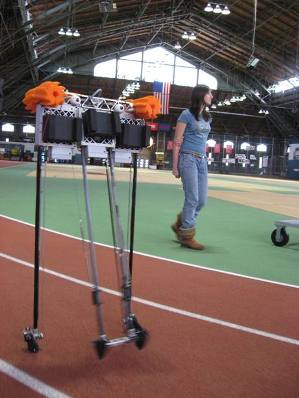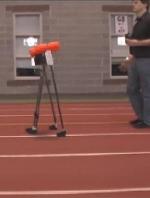High school student: Ben Oswald
Undergraduates: Carlos Arango, Steve Bagg, Megan Berry, John
Buzzi, Amy Chen, Alexis Collins, Stephane Constantin, James
Doehring, Gregory Falco, Hajime Furukawa, Alex Gates, Matt
Haberland, Avtar Khalsa, Andrew LeClaire, Emily Seong-hee Lee,
Reubens Lee, Alexander Mora, Andrew Mui, Nicole Rodia, Andrew
Spielberg, Yingyi Tan, Chen Kiang Tang, Kevin Ullmann, Max
Wasserman, Denise Wong
Graduate students: Pranav Bhounsule, Leticia Rojas-Camargo, Bram
Hendriksen (visiting from Delft), Rohit Hippalgaonkar, Ko Ihara,
DaniŽl Karssen (visiting from Delft), Sam Hsiang Lee, Gregg
Stiesberg, Andrey Turovsky
Lab Manager: Jason Cortell
Principal Investigator: Andy Ruina
Funding: NSF Robust Intelligence
(please let Andy know of any accidental omissions here)
Ranger 2008 ††††††††††(Looking for Ranger 2011?)Cornell Ranger Walks 5+ Miles: Thursday April 3, 2008 starting at 9:53 AM in Barton Hall, Cornell University Cornell's 4-legged bipedal robot Ranger
walked a distance of 9.07 km (5.6 mi) without being touched by a
person. That's almost 45 laps (a bit over 200 m each, the robot
was usually on the 3rd lane). That's 27,724 steps each covering
about 33 cm (13 inches) and each taking about 0.66 seconds. The
walk took 5 hours and 12 minutes. The average speed was 1.75
km/hr (about 1.1 mph). The robot mass was 8.5 kg of which 1.2 kg
was 11.1 volt lithium-ion rechargable batteries. The walk used
126 watt-hours (453 Kilojoules) of energy at an average rate of
just under 25 watts, of which about 5 watts was used for the 4
on-board computers and the IMU (inertial measurement unit). The
specific cost of transport (energy per weight per distance) was,
including the energy cost of the computers etc, about 0.60.
Was this a world record for an autonomous legged robot? We think so.Proposed rules for legged robot distance records Catalog of Pictures |
 |
|
|
The Team |
More about the Spring 2008 Ranger
This version of Ranger is a re-worked version of the robot which walked 1 km in December
2006. Changes include the addition of an IMU (inertial measurement
unit), 3 satellite computers, 3 ankle-angle encoders, a hip angle
encoder, a hip-angle spring, and more batteries. Additionally, the cable
drive was balanced to have equal stiffness on inner and outer legs and
the mass redistributed so that the inner and outer legs would be
dynamically nearly equal. The ankle gear ratios were changed. The
software was seriously reworked to incorporate various control
principles which we think are important (as will be explained in a
forthcoming paper).
Pre-emptive push off is still not possible. Cornell Ranger's specific energetic cost of transport has been reduced from 1.6 (December 2006) to 0.60 (April 2008). This is still much higher than the Collins robot (0.2), but still relatively low in the robot world. That is, the latest 54 kg Honda Asimo Humanoid uses about 1200 watts and can run at 6 km/hr. If it uses 1200 watts at full speed (can it literally run for an hour?) then it has a specific cost of tranport of about 1.3. Boston Dynamics BigDog is said to have a 25 hp motor and is about 250 kg fully loaded going perhaps 1.8 m/s. That gives a specific cost of transport of about 4 (or about 16, given 25% efficiency in converting gasoline to mechanical power). Humans have a specific cost of transport of about 0.2 (food energy per distance per weight). [A student was accidentally quoted in some press reports as saying that the Cornell Ranger uses 1000 times less energy than the Honda Humanoid. In fact the Cornell Ranger uses about 50 times less energy and is much lighter (and less versatile)]. The Cornell Ranger , while "passive" inspired, is not passive. The information flow rate is perhaps 10,000 times greater than for the Collins robot. The basic control loop runs once every millisecond and many quantities are measured with at least 8 bit accuracy. And all three joints are controlled. But the control philosophy is still pretty dumb: push off when sensing heelstrike, pick up the foot, swing the leg forward, put the foot down, wait for heel strike, repeat. We have found controller designs that use as little as 15 watts, however these are not sufficiently stable for long walks. If we can stabilize that walk, and use the full 160 watt-hours on our batteries Ranger could walk 18 km (over 11 mi). We'll see!! See many more pictures and videos and design sketches on the 2006 Ranger page
Pre-emptive push off is still not possible. Cornell Ranger's specific energetic cost of transport has been reduced from 1.6 (December 2006) to 0.60 (April 2008). This is still much higher than the Collins robot (0.2), but still relatively low in the robot world. That is, the latest 54 kg Honda Asimo Humanoid uses about 1200 watts and can run at 6 km/hr. If it uses 1200 watts at full speed (can it literally run for an hour?) then it has a specific cost of tranport of about 1.3. Boston Dynamics BigDog is said to have a 25 hp motor and is about 250 kg fully loaded going perhaps 1.8 m/s. That gives a specific cost of transport of about 4 (or about 16, given 25% efficiency in converting gasoline to mechanical power). Humans have a specific cost of transport of about 0.2 (food energy per distance per weight). [A student was accidentally quoted in some press reports as saying that the Cornell Ranger uses 1000 times less energy than the Honda Humanoid. In fact the Cornell Ranger uses about 50 times less energy and is much lighter (and less versatile)]. The Cornell Ranger , while "passive" inspired, is not passive. The information flow rate is perhaps 10,000 times greater than for the Collins robot. The basic control loop runs once every millisecond and many quantities are measured with at least 8 bit accuracy. And all three joints are controlled. But the control philosophy is still pretty dumb: push off when sensing heelstrike, pick up the foot, swing the leg forward, put the foot down, wait for heel strike, repeat. We have found controller designs that use as little as 15 watts, however these are not sufficiently stable for long walks. If we can stabilize that walk, and use the full 160 watt-hours on our batteries Ranger could walk 18 km (over 11 mi). We'll see!! See many more pictures and videos and design sketches on the 2006 Ranger page
What gives?
From a theoretical/scientific point of view this
robot is less interesting than the Collins machine. Ranger has 4 legs
instead of just two, no knees, a less natural gait and it uses more
energy. But there is a key difference. Ranger works most days. Thus we
can tune it and learn from it. The goal is to get back to the grace and
low-energy use of the Collins robot, but with reliability. Meanwhile the
Ranger seems to be a world record holder for autonomous legged robot
distance.
